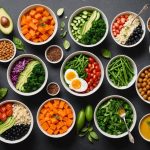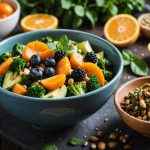Understanding Anti-Inflammatory Foods
Anti-inflammatory foods play a crucial role in maintaining optimal health by reducing inflammation within the body. Inflammation is a natural response to injury or infection, but chronic inflammation can lead to various health issues, including heart disease and arthritis. Therefore, integrating anti-inflammatory foods into your diet is essential.
Key Nutrients and Their Roles
Certain nutrients found in anti-inflammatory foods are instrumental in managing inflammation. For instance, omega-3 fatty acids, primarily found in fatty fish like salmon and mackerel, are known to decrease inflammatory markers. Similarly, antioxidants such as vitamin C, found abundantly in fruits like oranges and strawberries, help neutralise free radicals, mitigating inflammation throughout the body.
Also to discover : Unlocking the Power of Fermented Foods: Top Advantages of Adding Them to Your Diet
Moreover, polyphenols, present in foods like green tea and dark chocolate, provide anti-inflammatory properties by interacting with cellular pathways that regulate inflammation. Fibre, another essential nutrient, aids in maintaining healthy gut flora, which is associated with reduced inflammation.
Health Benefits of Anti-Inflammatory Foods
Including nutrient-rich ingredients in your diet offers expansive health benefits. Regular consumption of these foods is linked to a lowered risk of chronic diseases, improved cardiovascular health, and enhanced joint function. Over time, a diet rich in anti-inflammatory foods can contribute to an overall improved quality of life, reducing the risk of age-related ailments. Engaging with these foods not only promotes immediate health advantages but also supports long-term well-being.
Topic to read : Unlocking Fat Loss: A Step-by-Step Guide to Adding Interval Training to Your Cardio Routine
Simple Ways to Incorporate Anti-Inflammatory Foods
Incorporating anti-inflammatory foods into your diet can be straightforward with easy meal ideas and the right cooking techniques. By focusing on accessible ingredients, you can enhance your meals nutritionally and please your taste buds.
Breakfast Additions
Boost your mornings with simple additions. Start by adding a handful of berries or nuts to your oatmeal. Berries, such as blueberries and strawberries, are rich in antioxidants, while nuts like almonds and walnuts provide healthy fats. These ingredients not only enrich your breakfast but also contribute to lowering inflammation.
For a quick breakfast hack, blend a smoothie using anti-inflammatory ingredients like spinach, turmeric, and ginger alongside your favourite fruits. This nutritious mix can be made in minutes, perfect for busy mornings.
Lunch Enhancements
Lunch can be rejuvenating with the right elements. Consider building salads with leafy greens such as kale or spinach, complemented by healthy fats like avocado or olive oil. These simple salads can be both filling and beneficial for reducing inflammation.
Additionally, experiment with anti-inflammatory wraps or grain bowls. Combining whole grains like quinoa with a variety of colourful vegetables and proteins like chickpeas provides a balanced meal. For ease in preparation, try meal-prepping ingredients in advance to streamline your lunch-making process.
Substitution Strategies for Anti-Inflammatory Ingredients
Incorporating anti-inflammatory ingredients into your cooking can lead to healthier and more delicious meals. Start by focusing on ingredient substitutions for common unhealthy options. Instead of using white sugar, consider swapping it for honey or maple syrup, which not only reduce inflammation but also add a unique sweetness to your dishes. Refined grains can be replaced with whole grains, like quinoa or brown rice, providing more nutrients and fibres.
When it comes to enhancing flavor without extra calories, herbs and spices are your best friends. Instead of high-sodium seasoning, try incorporating turmeric, garlic, or ginger. These not only add depth to your recipes but also boast significant anti-inflammatory properties. Basil, oregano, and rosemary can elevate the taste profile of dishes while controlling calorie count.
For those who love baking and cooking, creative substitutions are key. Replace butter with avocado or olive oil, both of which promote heart health and have anti-inflammatory benefits. Instead of cream, experiment with coconut milk or almond milk, ensuring a creamy texture without the saturated fat.
With these cooking tips, you can easily transition to using anti-inflammatory ingredients, transforming your meals into health-boosting and flavorful experiences. These strategies not only contribute to better health outcomes but also diversify your culinary creativity.
Building a Grocery List for Anti-Inflammatory Meals
Creating a well-thought-out grocery shopping plan is vital for those aiming to incorporate anti-inflammatory meals into their diet. To ensure you have all the essential foods, start by focusing on whole, unprocessed ingredients that promote wellness and reduce inflammation.
Must-Have Items for an Anti-Inflammatory Kitchen
When meal planning, include items rich in antioxidants and omega-3 fatty acids. Consider stocking up on colorful fruits and vegetables, such as berries, spinach, and sweet potatoes. Healthy fats found in nuts, seeds, and olive oil are also crucial. Whole grains, like quinoa and brown rice, are better options than refined grains.
Tips on Shopping for Fresh, Organic Produce
Opt for organic produce to minimise exposure to pesticides which can trigger inflammation. Seek out local farmers’ markets for farm-fresh options that are both seasonal and nutrient-dense. Buying locally also supports your community and often provides fresher options than items that have traveled long distances.
Seasonal Considerations for Sourcing Ingredients
When grocery shopping, be mindful of the seasons. In-season produce is not only more flavorful but also more affordable. For example, root vegetables are abundant in the winter, while berries are a summer staple. Incorporating seasonal ingredients can enhance meal variety and sustainability in your anti-inflammatory diet.
Benefits of Specific Anti-Inflammatory Foods
Incorporating anti-inflammatory foods into your diet can provide substantial health benefits. Highlighting these foods maximizes your nutritional intake while managing inflammation effectively. Here’s a closer look at some top anti-inflammatory foods and how they can enhance your well-being.
Spotlight on Leafy Greens
Leafy greens, such as spinach and kale, are nutritional powerhouses. They are rich in vitamins A, C, and K, and high in antioxidants, all contributing to their inflammation reduction potential. Including these greens in your meals is both simple and rewarding. You can add them to smoothies, salads, or even as a base in a savoury wrap. A spinach and kale salad with a tangy vinaigrette is a delicious way to enjoy them.
The Power of Berries
Berries, filled with flavonoids and antioxidants, play a crucial role in combating inflammation. Integrate them easily by topping your cereal or yoghurt with fresh berries, or enjoy them in a smoothie. For a creative spin, try frozen berries in homemade popsicles or use them as a tangy filling for desserts, adding both health benefits and flavour.
Seafood as an Anti-Inflammatory Choice
Fatty fish like salmon and mackerel are packed with omega-3 fatty acids, known for their anti-inflammatory properties. Grilling or steaming these fish preserves their nutritional value. Opt for wild-caught varieties when possible to gain the most health benefits. Pair with a side of leafy greens for a balanced meal.











